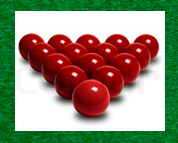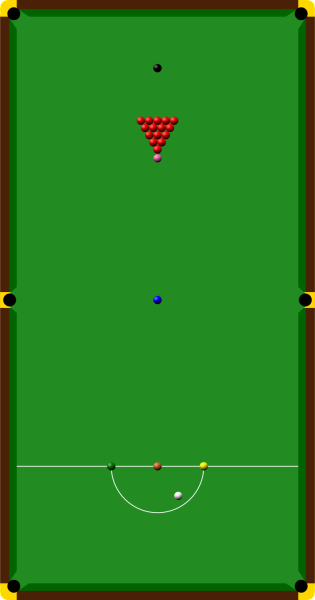
Snooker is a cue sport that is typically played on a table covered with a green cloth or baize, with pockets situated in each of the four corners and a further two, commonly referred to as the middle, or side pockets, that sit in the middle of each of the long side cushions. The (baize) cloth on a snooker table has a directional nap running from the baulk end of the table towards the end with the (black ball) spot. This affects how a ball rolls depending on which direction it is hit or shot. A regular (full-size) table measures 11 ft 8½ in × 5 ft 10 in (3569 mm x 1778 mm), commonly referred to as 12 × 6 ft.
It is played using a cue and 22 snooker balls: one white cue ball, 15 red balls worth one point each, and six balls of different colors: yellow (2 points), green (3), brown (4), blue (5), pink (6) and black (7). snooker-ball-valueA player (or team) wins a frame (individual game) of snooker by scoring more points than the opponent(s), using the cue ball to pot the red and colored balls. A player receives additional points if the opponent commits a foul. If the scores are equal when all the balls have been potted, the black is placed back on its spot as a tiebreaker. A player wins a match when a predetermined number of frames have been won.
Snooker, having been invented in India by British Army officers, is popular in many of the English-speaking and Commonwealth countries, with top professional players attaining multi-million-pound career earnings from the game.

The Game

The object of the game is to score more points than the opponent by potting object balls in the correct order. At the start of a frame, the balls are positioned as shown and the players take turns to hit a shot in a single strike from the tip of the cue, their aim being to pot one of the red balls and score a point. After the striker pots a red ball, he or she must pot one of the six ‘colors’. If successful, the value of the color potted is scored, and it is returned to its correct position on the table. After that, a red ball should be potted again. This process continues until the striker fails to pot the desired ball, at which point the opponent comes back to the table to play the next shot. The game continues in this manner until all the reds are potted and only the 6 colors are left on the table; at that point the colors must be potted in the order from least to most valued ball – that is, yellow first (because smallest value of 2 points), then green (3 points), brown (4 points), blue (5 points), pink (6 points) and finally black (7 points), the balls not being returned to play. When the final ball is potted, the player with more points wins. A player may also concede a frame while on strike if he or she thinks there are not enough points available on the table to beat the opponent’s score. In professional snooker this is a common occurrence. Points may also be scored in a game when a player’s opponent fouls. A foul can occur for numerous reasons, such as hitting a color first when the player was attempting to hit a red, potting the cue ball, or failing to escape from “a snooker” (a situation where the previous player left the cue ball where no legal ball can be struck at either edge without obstruction by an illegal ball). Points gained from a foul vary from a minimum of 4 to a maximum of 7 if the black ball is involved.
One game, from the balls in their starting position until the last ball is potted, is called a frame. A match generally consists of a predetermined number of frames and the player who wins the most frames wins the match. Competitive matches are officiated by a referee who is the sole judge of fair play. The referee also replaces the colors on the table when necessary and calls out how many points the player has scored during a break. Professional players usually play the game in a sporting manner, declaring fouls the referee has missed, acknowledging good shots from their opponent, or holding up a hand to apologize for fortunate shots, also known as “flukes”.
Other terminology used in snooker includes a player’s break, which refers to the total number of consecutive points a player has amassed (excluding fouls) when at one visit to the table. A player attaining a break of 15, for example, could have reached it by potting a red then a black, then a red then a pink, before failing to pot the next red. The traditional maximum break in snooker is to pot all reds with blacks then all colors, which would yield 147 points; this is often known as a “147″ or a “maximum”.
Accessories used for snooker include chalk for the tip of the cue, rests of various sorts (needed often, due to the length of a full-size table), a triangle to rack the reds, and a scoreboard. One drawback of snooker on a full-size table is the size of the room (22 by 16 feet (6.7 m × 4.9 m)), which is the minimum required for comfortable cueing room on all sides.

